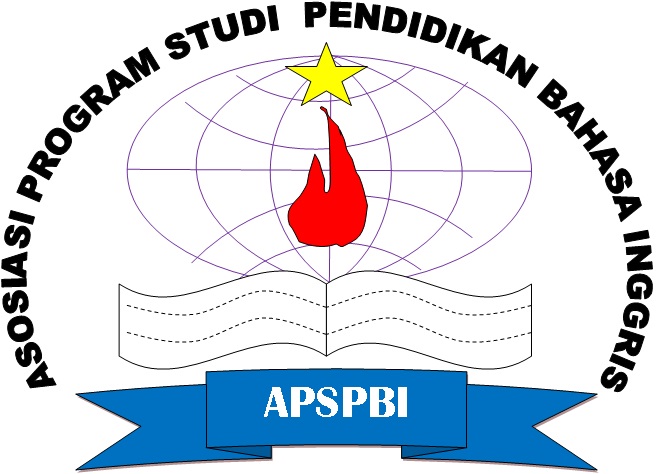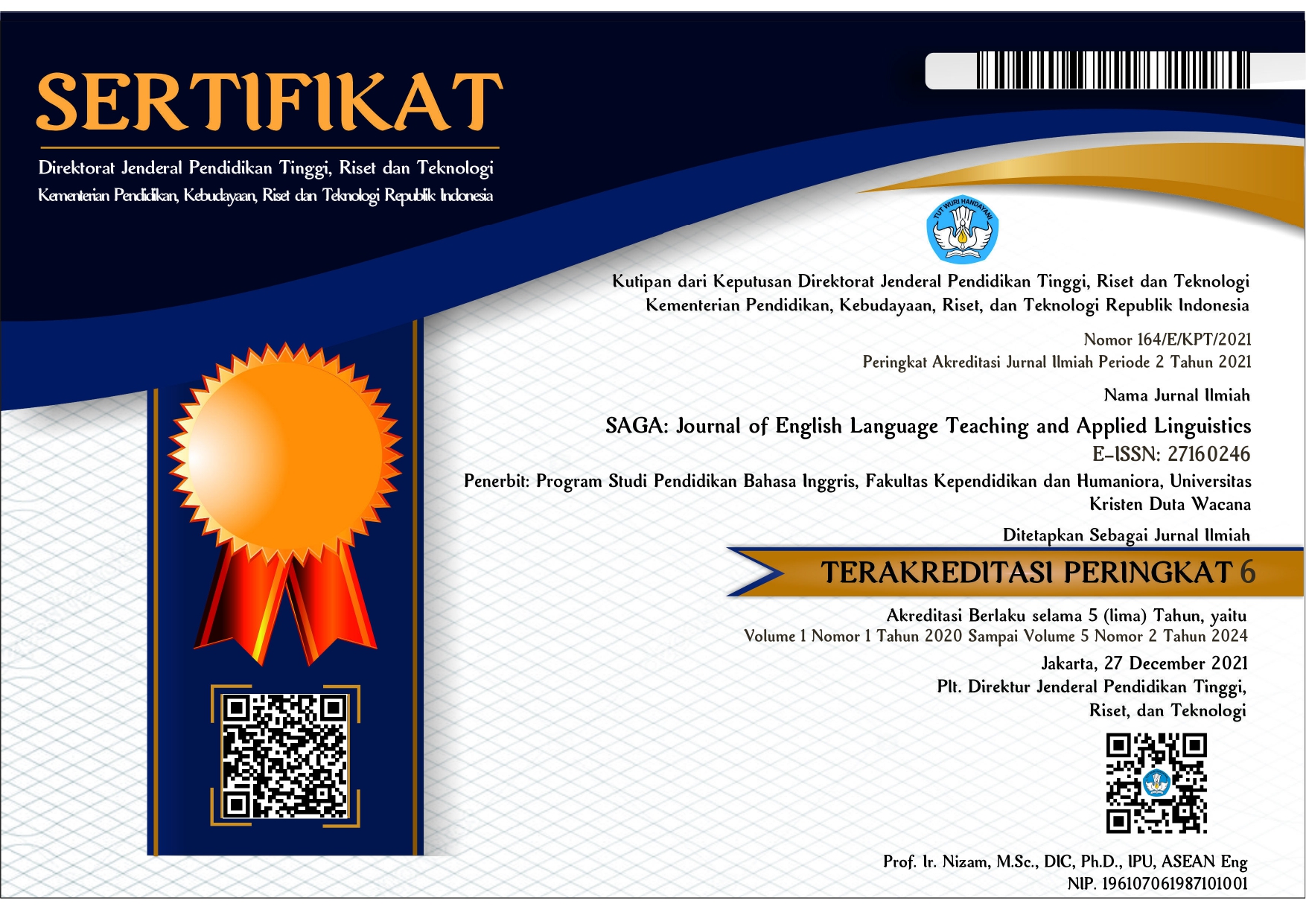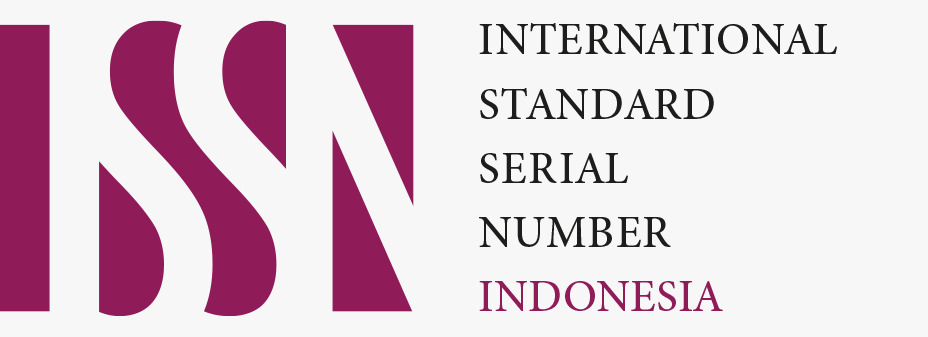Exploring Students’ Perception on The Implementation of a Web-Based Materials in Intensive Reading Class
DOI:
https://doi.org/10.21460/saga.2025.61.187Keywords:
Intensive reading, Website, Web-based materialsAbstract
Intensive Reading is one of reading subjects learned by English Department students. This course is a reading activity to find information and understand the contents of various reading texts. Good reading skills will enable students find and understand information from various texts proficiently. Besides knowing and applying reading strategies, students can improve their reading skills by doing reading practice continuously. Therefore, students need to have an easy access of various texts that are used as intensive reading materials. Website is one of the media that can be used to provide intensive reading materials. This is a descriptive qualitative research that is aimed to explore students’ perception on the implementation of a web-based materials in intensive reading class. The participants were the second semester of English Department students learned intensive reading. The data were obtained from observation, interview, and documentation. The findings showed that students have positive perception on the implementation of a web-based materials in intensive reading class. It was found that the implementation of websites can motivate students in learning to read, help students improve their reading comprehension, and form students’ reading habits.
References
Alghizzi, T. M., & Elyas, T. (2022). The effect of graded-reading websites / applications on EFL undergraduates’ reading comprehension during COVID-19 pandemic. Electronics, 11(11), 1751. https://doi.org/https://doi.org/10.3390/electronics11111751
Bana, A. (2020). Students’ perception of using the internet to develop reading habits. JET (Journal of English Teaching), 6(1), 60–70. https://doi.org/10.33541/jet.v6i1.46
Biancarosa, G., & Piper, G. G. (2012). Technology tools to support reading in the digital age. The Future of Children, 22, 139–160. https://doi.org/10.2307/23317415
Brandl, K. (2002). The integration of internet-based reading materials into the foreign language curriculum: From teacher- to student-centered approaches. Language Learning & Technology, 6(3), 87–107. http://dx.doi.org/10125/25178
Dehghanpour, E., & Hashemian, M. (2015). efficiency of using a web-based approach to teach reading strategies to Iranian EFL learners. English Language Teaching, 8(10), 30–41. https://doi.org/10.5539/elt.v8n10p30
Elmayantie, C. (2018). Pemanfaatan internet dalam pembelajaran bahasa Inggris oleh guru Sekolah Menengah Kejuruan Negeri 1 Palangka Raya. Jurnal Saintekom, 8(1), 65–77. https://doi.org/10.33020/saintekom.v8i1.51.
Erwinda, F. Y., Ashari, Wardani, E., & Kariadi, M. T. (2021). Improving students’ reading comprehension through internet-sourced reading materials as English teaching media. Journal of English Literature, Linguistic, and Education, 2(2), 18–33. https://doi.org/http://dx.doi.org/10.31941/jele.v2i2.1622
Harminingtyas, R. (2014). Analisis layanan website sebagai media promosi, media transaksi dan media informasi dan pengaruhnya terhadap brand image perusahaan pada Hotel Ciputra. Jurnal STIE Semarang, 6(3), 37–57. https://jurnal3.stiesemarang.ac.id/index.php/jurnal/article/view/120
Hazarika, D. Z. (2017). Exploring the impact of technology in teaching English: TESOL in the context. European Journal of English Language and Literature Studies, 5(10), 19–28. https://www.eajournals.org/wp-content/uploads/Exploring-the-Impact-of-Technology-in-Teaching-English-Tesol-in-the-Context.pdf
Helmers, J. R. (2017). Using technology and collaboration to support reading comprehension. Master’s Thesis, Northwestern College, Orange City, IA. https://nwcommons.nwciowa.edu/cgi/viewcontent.cgi?article=1035&context=education_masters
Hernawati, K. (2010). Pengenalan Internet dan Blog Wordpress. https://staffnew.uny.ac.id/upload/132309677/pengabdian/modul-pelatihan-blog.pdf
Insuasty Cardenas, A. (2020). Enhancing reading comprehension through an intensive reading approach. How, 27(1), 69–82. https://doi.org/10.19183/how.27.1.518
Kabir, T. S. (2020). Teachers’ and students’ perception of using translation (L1) for developing reading skill. Shanlax International Journal of English, 8(4), 1–11. https://doi.org/10.34293/english.v8i3.3253
Khazaal, E. N. (2019). Impact of intensive reading strategy on English for specific purposes college students’ in developing vocabulary. Arab World English Journal, 10(2), 181–195. https://doi.org/10.24093/awej/vol10no2.15
Leip. (2024). Informatics Practices. https://ncert.nic.in/textbook/pdf/leip105.pdf
Macancela, J. M. (2019). Websites as support tools for learning the English language. Journal of Science and Research: Revista Ciencia E Investigaci ´On, 4(2), 13–20. https://doi.org/https://doi.org/10.5281/zenodo.3240648 Jacqueline
Male, H. (2019). Proceeding EFL theory & practice voice of EED UKI. In P. Pardede (Ed.), English Education Departement Collegiate Frofum (EED CF) (Issue January 2019, pp. 147–159). UKI Press. https://www.researchgate.net/publication/336460072_EFL_Theory_and_Practice_Voice_of_EED_UKI
Masruddin. (2014). The importance of using technology in English teaching and learning. IDEAS: Journal on English Language Teaching and Learning, Linguistics and Literature, 2(2). https://doi.org/https://doi.org/10.24256/ideas.v2i2.36
Moon, R. C., & Kwan, S. H. (2022). Improving students’ intensive reading ability by using Survey-Question-Read-Review-Recite-Reflect Method. Jelita, 3(1), 12–21. https://doi.org/10.56185/jelita.v3i1.95
Muchtar, N. (2019). Intensive and extensive reading in improving teaching reading comprehension. Lingua Pedagogia (Journal of English Teaching Studies), 1(2), 1–13. https://doi.org/10.21831/lingped.v1i2.18687
Prayudi, R. A., Hakiki, A. K., Putra, N. R. D. P., Anzka, T. O., & Ihsan, M. T. (2021). The use of technology in English teaching & learning process. JRIP: Jurnal Riset Dan Inovasi Pembelajaran, 1(2), 102–111. https://doi.org/https://doi.org/10.51574/jrip.v1i2.38
Rahmawati, O. I., Nurdianingsih, F., & Fitrianingsih, A. (2021). Motivating students to read uses online digital module oktha. Prosiding Nasioinal Pendidikan: LPPM IKIP Bojonegoro, 2(1), 236–240. https://jurnal.unimus.ac.id/index.php/ELLIC/index
Ratnasari, E., Nurhidayat, E., & Fakhruddin, A. (2018). Kahoot application as technology resources in teaching reading comprehension. Journal of English Language Learning (JELL), 2(1), 1–6. https://media.neliti.com/media/publications/318847-kahoot-application-as-technology-resourc-a746e939.pdf
Richards, J. C. (2015). Technology in language teaching today. Indonesian JELT, 10(1), 18–32. https://doi.org/https://doi.org/10.25170/ijelt.v10i1.1506
Satriani, E. (2017). The effect of using online reading resources toward students’ reading comprehension in extensive reading class. J-SHMIC: Journal of English for Academic, 4(2), 37–47. https://doi.org/https://doi.org/10.25299/jshmic.2017.vol4(2).668
Suriaman, A., Rahman, A., & Noni, N. (2018). Developing web-based English instructional material oriented to promote independent learning at indonesian university context. Journal of Language Teaching and Research, 9(2). https://doi.org/http://dx.doi.org/10.17507/jltr.0902.15
Tanjung, F. Z., Ridwan, & Gultom, U. A. (2017). Reading habits in digital era: A research on the students in Borneo University. LLT: Language and Language Teaching Journal, 20(2), 147–157. https://doi.org/doi.org/10.24071/llt.2017.200209
Velandia, Marlen & Pedreros, Andres & Alí, Mónica. (2012). Using web-based activities to promote reading: An exploratory study with teenagers. Profile Issues in Teachers` Professional Development. 14. 11-27. https://www.researchgate.net/publication/262661845_Using_Web-Based_Activities_to_Promote_Reading_An_Exploratory_Study_with_Teenagers
















